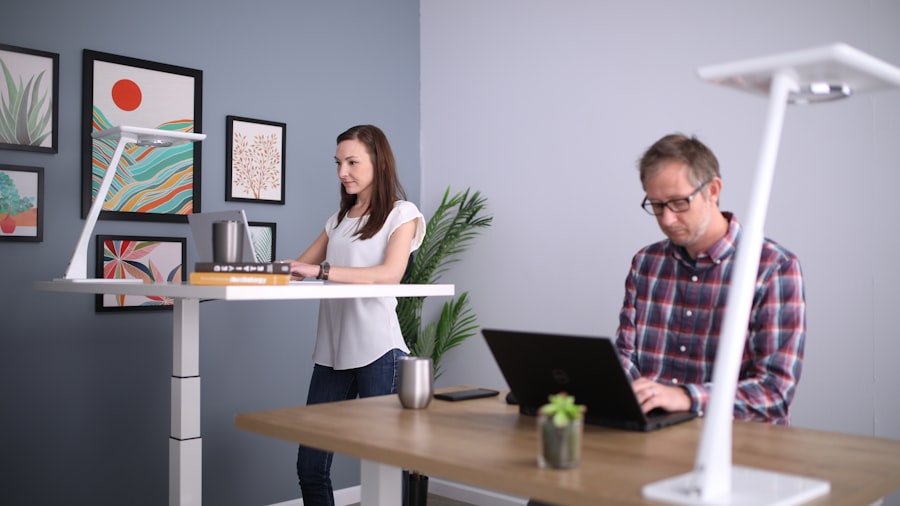The transition from traditional sitting desks to sitting to standing desks has gained significant traction in recent years, primarily due to the growing awareness of the health risks associated with prolonged sitting. One of the most notable benefits of using a sitting to standing desk is the potential reduction in the risk of chronic diseases. Research has shown that extended periods of sedentary behavior can lead to conditions such as obesity, diabetes, and cardiovascular disease.
By alternating between sitting and standing, individuals can promote better circulation and metabolic function, which may help mitigate these risks. In addition to physical health benefits, using a sitting to standing desk can also enhance mental well-being and productivity. Standing while working can lead to increased energy levels and improved mood, as it encourages more dynamic movement and engagement with the work environment.
Studies have indicated that employees who use standing desks report higher levels of job satisfaction and focus. This shift in posture can also stimulate creativity and problem-solving abilities, making it easier for individuals to tackle complex tasks and generate innovative ideas.
Key Takeaways
- Sitting to standing desks can improve posture, reduce back pain, and increase energy levels.
- Proper setup of a sitting to standing desk involves adjusting the height, positioning the monitor at eye level, and using an anti-fatigue mat.
- Transitioning to a sitting to standing desk should be done gradually, alternating between sitting and standing and taking regular breaks.
- Ergonomics is crucial for a sitting to standing desk, including proper keyboard and mouse placement, and maintaining a neutral body position.
- Complement your sitting to standing desk routine with exercises like stretching, walking, and yoga to promote movement and reduce stiffness.
How to Properly Set Up Your Sitting to Standing Desk
Setting up a sitting to standing desk correctly is crucial for maximizing its benefits and ensuring comfort throughout the workday. The first step in achieving an ergonomic setup is to adjust the desk height so that your elbows are at a 90-degree angle when typing. Your wrists should remain straight, and your hands should float comfortably above the keyboard.
The monitor should be positioned at eye level or slightly below, allowing you to maintain a neutral neck position without straining. In addition to desk height, consider the placement of other essential items on your workspace. The mouse should be positioned close to the keyboard to minimize reaching, and any frequently used items should be within easy reach to avoid unnecessary strain.
If you are using a laptop, an external keyboard and mouse can help achieve a more ergonomic setup. Furthermore, using a footrest can provide additional support and encourage proper posture while standing.
Tips for Transitioning to a Sitting to Standing Desk

Transitioning from a traditional desk setup to a sitting to standing desk can be a significant adjustment for many individuals. To ease into this new routine, it is advisable to start slowly by alternating between sitting and standing throughout the day. For instance, begin with standing for 15-30 minutes every hour and gradually increase the duration as your body adapts.
This incremental approach allows your muscles and joints to adjust without causing fatigue or discomfort. Another effective strategy is to incorporate movement into your standing time. Simple activities such as shifting your weight from one foot to the other, doing calf raises, or even taking short walks around the office can help alleviate any stiffness that may arise from standing still for too long.
Additionally, consider using reminders or timers to prompt you to switch positions regularly, ensuring that you maintain a balanced approach throughout your workday.
The Importance of Ergonomics in a Sitting to Standing Desk
Ergonomics plays a pivotal role in the effectiveness of a sitting to standing desk setup. A well-designed ergonomic workspace not only enhances comfort but also reduces the risk of musculoskeletal disorders that can arise from poor posture or improper equipment placement. When setting up your desk, it is essential to consider factors such as chair height, monitor distance, and keyboard positioning.
Each element should work in harmony to create an environment that supports your body’s natural alignment. Moreover, investing in ergonomic accessories can further enhance your workspace. For example, an adjustable chair with lumbar support can help maintain proper spinal alignment while seated, while an anti-fatigue mat can provide cushioning and support when standing.
These small adjustments can make a significant difference in overall comfort and productivity, allowing you to focus on your work rather than discomfort or pain.
Exercises to Complement Your Sitting to Standing Desk Routine
Incorporating exercises into your daily routine can significantly enhance the benefits of using a sitting to standing desk. Simple stretches and movements can help alleviate tension and improve circulation throughout the day. For instance, consider performing neck stretches by gently tilting your head from side to side or rolling your shoulders back and forth.
These exercises can help relieve stiffness that may accumulate from prolonged periods of sitting or standing. Additionally, integrating strength-building exercises into your routine can further support your overall health. Bodyweight exercises such as squats, lunges, or even desk push-ups can be performed during breaks or while transitioning between sitting and standing.
These movements not only strengthen key muscle groups but also promote better posture and stability, which are essential for maintaining comfort during long work hours.
Choosing the Right Sitting to Standing Desk for Your Workspace

Selecting the appropriate sitting to standing desk for your workspace involves considering several factors that align with your specific needs and preferences. One of the primary considerations is adjustability; look for desks that offer a wide range of height settings to accommodate both sitting and standing positions comfortably. Electric desks often provide smoother transitions compared to manual options, making it easier to switch between positions throughout the day.
Another important aspect is the size of the desk surface. Ensure that the desk provides ample space for your computer, documents, and any other essential items you may need while working. Additionally, consider the design and aesthetics of the desk; a visually appealing workspace can enhance motivation and productivity.
Finally, read reviews and seek recommendations from others who have experience with specific models to ensure you make an informed decision.
Common Mistakes to Avoid When Using a Sitting to Standing Desk
While sitting to standing desks offer numerous benefits, there are common pitfalls that users should be aware of to maximize their effectiveness. One prevalent mistake is failing to adjust the desk height properly. If the desk is too high or too low, it can lead to discomfort or strain in the neck, shoulders, or wrists.
Always take the time to fine-tune your setup based on your body’s dimensions and preferences. Another mistake is remaining in one position for too long, whether sitting or standing. It’s essential to maintain a dynamic work routine by alternating positions regularly and incorporating movement throughout the day.
Additionally, neglecting proper footwear can also impact comfort; wearing supportive shoes while standing can help reduce fatigue and discomfort over time.
Maximizing Productivity with a Sitting to Standing Desk
To fully harness the productivity potential of a sitting to standing desk, it’s essential to create an environment conducive to focus and efficiency. One effective strategy is to establish a routine that incorporates both sitting and standing periods strategically throughout the day. For example, consider reserving specific tasks that require deep concentration for when you are seated, while using standing time for more collaborative activities or brainstorming sessions.
Moreover, minimizing distractions in your workspace can significantly enhance productivity levels. Keep your desk organized and clutter-free, as a tidy environment fosters better focus. Additionally, consider using noise-canceling headphones or playing background music that promotes concentration during work periods.
By creating an intentional workspace that supports both physical comfort and mental clarity, you can maximize your productivity while using a sitting to standing desk.
Creating a Healthy Work Environment with a Sitting to Standing Desk
A healthy work environment extends beyond just having a sitting to standing desk; it encompasses various elements that contribute to overall well-being. Incorporating plants into your workspace can improve air quality and create a calming atmosphere that enhances focus and reduces stress levels. Studies have shown that exposure to greenery can lead to increased productivity and creativity among employees.
Furthermore, fostering social connections within the workplace is vital for mental health. Encourage regular breaks with colleagues or engage in team-building activities that promote camaraderie and collaboration. A supportive work culture not only enhances job satisfaction but also contributes positively to overall health outcomes.
The Impact of Sitting to Standing Desks on Overall Health and Wellbeing
The impact of sitting to standing desks on overall health and well-being is profound and multifaceted. Research indicates that individuals who incorporate standing into their work routine experience lower levels of fatigue and discomfort compared to those who remain seated for extended periods. This shift in posture not only promotes better circulation but also encourages more active engagement with tasks at hand.
Moreover, the psychological benefits associated with using a sitting to standing desk cannot be overlooked. Many users report feeling more energized and motivated when they have the option to stand while working. This increased sense of agency over one’s work environment contributes positively to mental health outcomes, reducing feelings of stress and anxiety often associated with sedentary work habits.
Incorporating Movement into Your Workday with a Sitting to Standing Desk
Incorporating movement into your workday is essential for reaping the full benefits of a sitting to standing desk setup. Simple strategies such as taking short walking breaks every hour or utilizing walking meetings can significantly enhance physical activity levels throughout the day. Consider setting reminders on your phone or computer to prompt you to stand up, stretch, or take a brief walk around the office.
Additionally, integrating movement into your daily routine doesn’t have to be limited to breaks; consider using dynamic movements while working at your desk as well. For instance, try shifting your weight from one foot to another or performing gentle stretches during phone calls or virtual meetings. These small adjustments can help keep your body engaged and energized while promoting overall well-being throughout your workday.
If you are looking to maximize comfort and productivity in your workspace, consider investing in ergonomic furniture. According to a recent article on officeinterior.ae, ergonomic furniture can help reduce strain on your body and improve overall well-being. One key piece of ergonomic furniture to consider is a height-adjustable desk, as discussed in another article on officeinterior.ae. By transitioning from sitting to standing throughout the day, you can improve your posture and reduce the risk of health issues associated with prolonged sitting. Creating a productive workspace with interior office design is essential, and incorporating ergonomic furniture like a height-adjustable desk can make a significant difference.


